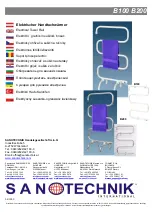
Section 3, Installing the Exhaust System
The exhaust and outlet are HOT and the surrounding
areas must be thermally shielded and protected from the
hot surfaces and heat buildup by insulation. Nothing can
come into inadvertent contact with any part of the
exhaust system
! DANGER
•
Exhaust pipe must have a minimum of 3” (7.6 cm)
clearance from all surfaces.
•
Ensure that the exhaust cannot be plugged or restricted.
•
The exhaust fitting on The WaterHeater™ by ITR is
1.5”
O.D. and the exhaust pipe used must have a
minimum of 1.5” I.D throughout its length.
•
All exhaust elbows must be of a large radius design
(minimum radius 2.0”).
•
The exhaust must be supported a minimum of every 3’ of
its installed length.
•
The exhaust and The WaterHeater™ by ITR connection
point must use appropriate clamps and sealing compound
to ensure that the connections are tight and leak free. The
WaterHeater™ by ITR exhaust outlet pipe and the exhaust
pipe itself must not be distorted or damaged during this
process.
•
When The WaterHeater™ by ITR is running, the connection
points and the system must be checked for leaks and any
found must be corrected. Periodically, check the exhaust
fittings, connections, exhaust tube and insulation for leaks
and integrity and correct if required.
•
Appropriate exhaust insulation must be used to cover the
entire length of any interior exhaust run.
•
Solid stainless steel exhaust tubing is recommended but
an approved stainless steel flexible exhaust tubing can be
used. If flexible exhaust tubing is used the exhaust tubing
must be inspected regularly for leaks and deterioration as
this type of exhaust does not have the life expectancy of
solid tubing. Stepped band clamps are recommended for
joining flex and solid tubing as they apply firm, even
pressure.
•
In a coach, install an exhaust collar on the exhaust pipe to
isolate the pipe from the coach.
International Thermal Research
3-3
















































